Your gemstone coatings will last longer when you choose advanced application methods like PVD or CVD, which create molecular-level bonds with superior durability. You’ll need proper surface preparation including thorough cleaning, etching, and primer application to guarantee strong adhesion. Multiple thin layers outperform single thick coats, while titanium vapor deposition offers the best chemical resistance. Regular maintenance with soft cloths and avoiding harsh chemicals prevents premature deterioration. Understanding these factors helps you maximize your coating investment.
Understanding Surface Coating Technology and Application Methods
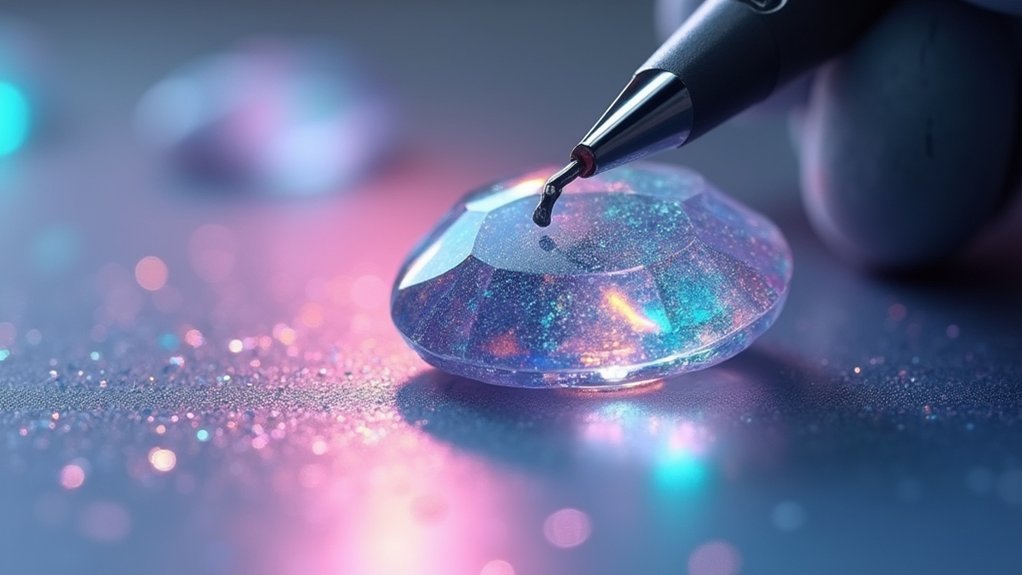
Several advanced technologies transform ordinary gemstones into stunning, durable pieces through precise surface coating applications.
You’ll encounter two primary methods: Physical Vapor Deposition (PVD) and Chemical Vapor Deposition (CVD). These techniques create incredibly thin yet robust layers that enhance your gemstone’s appearance while providing essential protection.
When you’re exploring coating options, you’ll find organic dye surface coating penetrates the gemstone for natural-looking color enhancement.
Interference film coatings use multiple layers to create mesmerizing color-change effects through light manipulation.
Titanium vapor deposition delivers metallic sheens with color variations based on coating thickness, offering vibrant visual effects.
Each surface coating method serves specific purposes, from protecting soft gemstones against scratches and environmental damage to creating spectacular visual transformations that extend your gemstone’s lifespan considerably.
Quality of Base Materials and Their Impact on Coating Adhesion
You’ll find that your gemstone’s surface quality directly determines how well coatings bond and last over time.
Your preparation techniques—from thorough cleaning to strategic etching—create the foundation that makes or breaks coating adhesion.
Understanding how your specific gemstone material interacts with different coating types guarantees you’re choosing compatible combinations that won’t fail prematurely.
Surface Preparation Techniques
Achieving lasting gemstone coatings begins with meticulous surface preparation, where the quality of your base materials directly determines how well the coating will adhere and endure over time.
You’ll need to employ specific surface preparation techniques to maximize coating longevity. Start by thoroughly cleaning your gemstone to remove oils, dust, and residues that prevent proper bonding.
Next, create micro-textures through controlled sanding or blasting, which enhances mechanical interlocking between the coating and substrate.
Don’t overlook primers or adhesion promoters—they’ll greatly boost bonding strength across various gemstone types.
Proper conditioning prevents delamination and guarantees your coating remains intact under stress and environmental changes, delivering the durable, long-lasting results you’re seeking.
Material Compatibility Factors
When selecting gemstones for coating applications, the fundamental properties of your base material will determine whether you achieve professional-grade results or face premature coating failure.
Understanding material compatibility factors starts with evaluating your gemstone’s hardness and porosity levels. Harder stones like sapphires and diamonds provide superior coating adhesion compared to softer materials such as pearls or turquoise.
You’ll also need to take into account your gemstone’s chemical composition when choosing coating materials. Metallic coatings often struggle with porous stones, creating weak bonds that lead to peeling.
Additionally, surface inclusions and imperfections create adhesion challenges that compromise coating integrity over time. By carefully matching your coating selection to your gemstone’s inherent properties, you’ll greatly extend the durability and performance of your finished piece.
Professional-Grade Sealants vs. Standard Coating Options
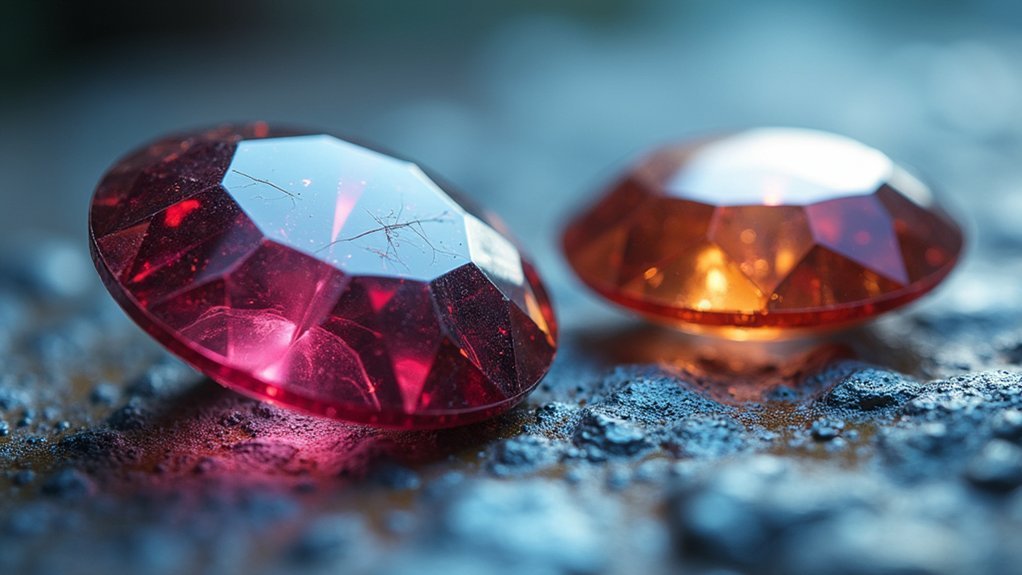
You’ll notice significant differences in how professional-grade sealants and standard coatings are formulated, with epoxy resins offering advanced chemical compositions that outperform simpler alternatives.
When comparing durability, professional-grade options consistently demonstrate superior resistance to scratches, UV damage, and environmental wear over extended periods.
The application techniques you’ll use also vary considerably, as professional sealants require more precise methods to achieve their enhanced protective barrier formation.
Professional-Grade Composition Differences
Professional-grade sealants distinguish themselves from standard coating options through their superior chemical composition, featuring notably higher concentrations of durable resins and polymers that create a more robust protective barrier.
You’ll find these advanced formulations offer exceptional bonding strength with gemstone surfaces, ensuring your protective coating won’t chip or peel easily. The enhanced chemical makeup delivers considerably better performance:
- Higher resin concentrations provide superior scratch resistance
- Advanced polymers extend coating lifespan by years
- UV inhibitors prevent discoloration from sunlight exposure
- Specialized bonding agents create stronger surface adhesion
- Multi-layer compatible formulas allow enhanced protection
Professional-grade sealants undergo extensive testing protocols that standard coatings typically skip, ensuring consistent performance over time.
These rigorous quality standards mean you’re investing in protection that maintains its effectiveness longer, requiring fewer reapplications.
Durability Performance Comparison
While standard coating options provide basic protection for your gemstones, they can’t match the exceptional durability performance that professional-grade sealants deliver over extended periods.
You’ll notice professional-grade options outlast standard coatings by years, not months. Their superior polymer composition creates stronger molecular bonds that resist daily wear and environmental damage more effectively.
Standard coatings typically require reapplication every few months as they wear off quickly.
Professional-grade sealants maintain their protective barrier for several years with proper care. You’ll also experience better chemical resistance with professional options, ensuring your gemstone coatings won’t deteriorate from household cleaners or harsh substances.
The multi-layer application process further enhances durability by building a thicker, more resilient protective shield that standard single-layer coatings simply can’t provide.
Application Technique Requirements
Achieving these superior durability results requires mastering specific application technique requirements that differ markedly between professional-grade sealants and standard coating options.
Professional-grade sealants demand precise environmental controls and methodical surface preparation that standard coatings don’t require.
Your success depends on following these critical steps:
- Clean and roughen the gemstone surface thoroughly to maximize coating adherence
- Control temperature and humidity levels during application for ideal curing
- Apply multiple thin coats rather than single thick layers
- Allow proper curing time between each application layer
- Use specialized tools designed for professional-grade sealants
Standard coatings offer more forgiving application processes but sacrifice longevity.
Professional-grade sealants require technical expertise and controlled conditions, yet they’ll reward you with exceptional durability and reduced maintenance needs.
Multiple Layer Application Techniques for Enhanced Protection
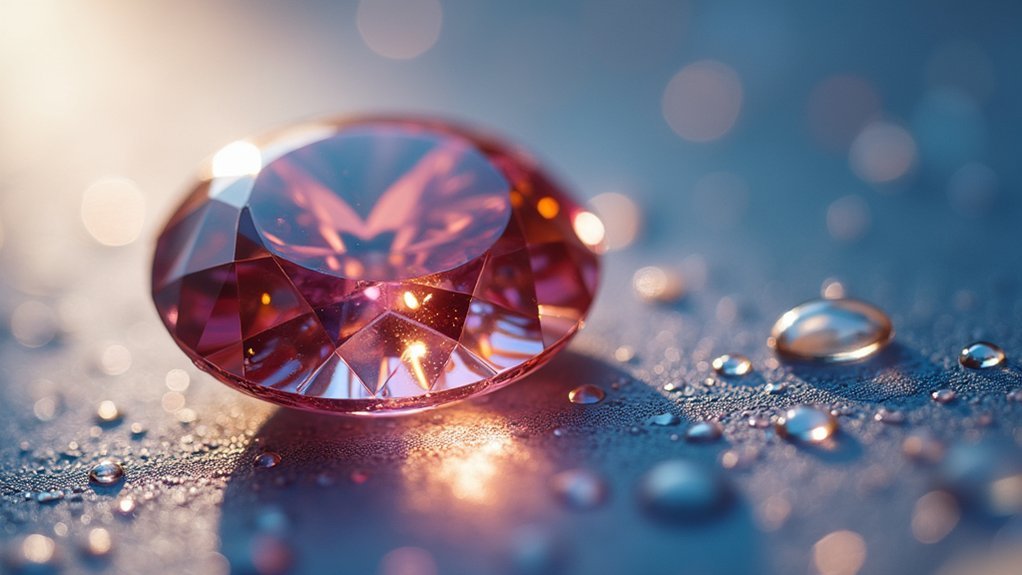
When you’re looking to maximize your gemstone coating’s protective capabilities, multiple layer application techniques offer superior durability compared to single-layer treatments.
PVD and CVD methods create robust coatings by applying several thin layers, each tailored for specific properties like scratch resistance or anti-reflective qualities. You’ll find interference film coatings particularly effective, combining multiple materials to provide both aesthetic enhancement and protection against external damage.
Applying these coatings in controlled environments minimizes impurities and guarantees better adhesion, which is critical for longevity.
Controlled application environments ensure minimal contamination and optimal coating adhesion, directly impacting the long-term durability of gemstone treatments.
You can greatly extend your gemstone’s surface treatment lifespan through regular maintenance and inspections. This proactive approach helps you identify wear early, allowing for timely reapplication that preserves your gemstone’s appearance and protective qualities over time.
Surface Preparation Methods That Maximize Coating Longevity
Even the most advanced multiple layer coating systems will fail if you don’t properly prepare the gemstone surface beforehand.
Surface preparation methods form the foundation of coating longevity, determining whether your investment lasts months or years.
Effective surface preparation methods that enhance coating durability include:
- Deep cleaning – Remove all dirt, oil, and residues using specialized solvents to guarantee pristine adhesion surfaces
- Primer application – Apply gemstone-specific primers that create ideal bonding conditions between stone and coating
- Surface texturing – Use sandblasting or etching techniques to create micro-abrasions for improved mechanical adhesion
- Complete moisture removal – Thoroughly dry surfaces to prevent trapped moisture causing future peeling or bubbling
- Environmental control – Maintain stable temperature and humidity during preparation to maximize coating performance
Temperature and Environmental Factors Affecting Coating Stability
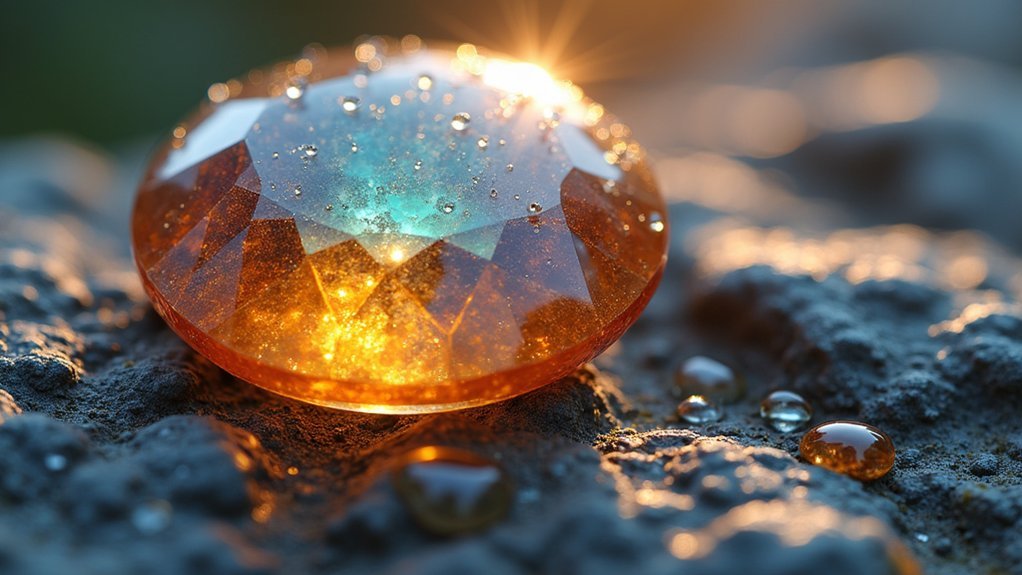
Temperature and environmental conditions act as silent destroyers of gemstone coatings, systematically breaking down even the most carefully applied protective layers. Understanding these environmental factors helps you protect your investment and maintain coating integrity.
| Environmental Factor | Impact on Coatings | Prevention Method |
|---|---|---|
| Temperature fluctuations | Expansion/contraction leading to cracking | Store in stable climate conditions |
| High humidity | Accelerates deterioration of organic dyes | Use water-resistant coatings |
| UV exposure | Causes fading and discoloration | Keep away from direct sunlight |
You’ll notice abrasive conditions like pollutants and harsh chemicals wear down protective layers quickly. Regular inspection in varying conditions helps identify early wear signs, allowing timely reapplication. Gentle cleaning methods and proper storage considerably extend coating lifespan by minimizing exposure to damaging temperature and environmental factors.
Chemical Resistance Properties of Different Coating Types
When you’re evaluating coating durability, you’ll find that acid exposure resistance varies dramatically between coating types, with PVD and CVD options markedly outperforming organic dyes.
Your coating’s ability to withstand alkali chemicals depends largely on the material composition, as gold and platinum coatings excel in harsh alkaline environments while organic treatments deteriorate rapidly.
You’ll achieve the best chemical protection by selecting interference film or metallic coatings that resist both acidic and basic substances throughout your gemstone’s lifetime.
Acid Exposure Resistance
Since acidic substances pose one of the greatest threats to gemstone coating integrity, understanding how different coating types respond to acid exposure becomes essential for maintaining your treated stones.
Your coating’s acid exposure resistance varies greatly based on its composition and application method.
Here’s what you need to know about different coating vulnerabilities:
- Organic dye coatings suffer the most damage from acidic substances, showing rapid degradation and color loss.
- Titanium Vapor Deposition provides superior chemical resistance, withstanding acidic environments better than most alternatives.
- Aurora/Mystic coatings experience metallic oxide layer corrosion over time when exposed to acids.
- Polymer-incorporated coatings offer enhanced acid resistance compared to pure metal oxide formulations.
- Regular maintenance avoiding acidic cleaners greatly extends coating lifespan.
Choose coatings wisely based on your exposure expectations.
Alkali Chemical Durability
While acids present serious challenges to coating integrity, alkaline substances create their own unique set of durability concerns for your treated gemstones. Your coating’s alkali chemical durability depends heavily on the type you’ve selected. Titanium vapor deposition outperforms organic dyes, which fade quickly when exposed to alkaline solutions. You’ll find protective polyurethane or resin coatings offer superior resistance, especially for softer stones.
| Coating Type | Alkali Resistance | Durability Rating |
|---|---|---|
| Titanium Vapor | Superior | High |
| Metallic Oxides | Enhanced | Medium-High |
| Organic Dyes | Poor | Low |
Metallic oxide coatings provide enhanced resistance through stable chemical bonds formed during deposition. You can extend your coating’s life by avoiding harsh chemicals and conducting regular inspections to maintain ideal alkali chemical durability.
Physical Durability Comparison Among Coating Technologies
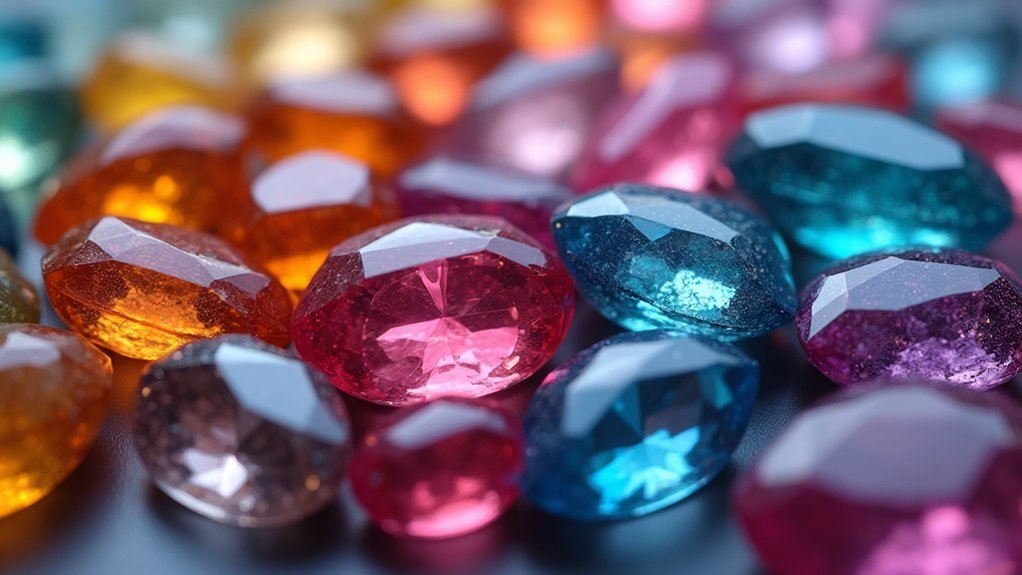
Although gemstone coatings share the common goal of enhancing appearance, their physical durability varies dramatically based on the underlying technology used.
You’ll find significant differences when comparing coating technologies for scratch resistance, wear tolerance, and longevity.
Here’s how different coating technologies stack up physically:
- PVD coatings deliver superior scratch resistance and wear tolerance compared to traditional surface treatments.
- CVD techniques create molecular-level bonds that outperform organic dye coatings in environmental resistance.
- Titanium vapor deposition maintains metallic sheen longer with reduced fading and chipping.
- Protective anti-reflective layers shield gemstones from both physical damage and chemical deterioration.
- Interference film coatings use multiple structural layers for enhanced durability alongside aesthetic benefits.
Understanding these differences helps you choose coatings that match your durability requirements.
Proper Cleaning Techniques That Preserve Coating Integrity
When you invest in coated gemstones, proper cleaning becomes critical to preserving their enhanced appearance and extending their lifespan.
You’ll want to use only lukewarm water mixed with mild soap, avoiding harsh cleaning products that can degrade the coating’s integrity. Always clean with a soft, lint-free cloth to prevent scratching the delicate coated surface.
After washing, rinse thoroughly with clean water to remove soap residue that could attract dirt and diminish the coating’s shine.
Store your coated gemstones separately from other jewelry to prevent abrasion during storage.
Don’t forget to regularly inspect the coating for wear or damage signs.
Timely professional maintenance helps preserve the coating’s integrity and greatly prolongs its lifespan, protecting your investment.
Storage Conditions That Extend Coating Lifespan
Proper storage conditions play an essential role in maximizing your coated gemstones’ lifespan and maintaining their enhanced beauty.
Proper storage significantly extends coated gemstone longevity while preserving their enhanced aesthetic appeal and overall value.
Creating the right environment protects delicate coatings from deterioration and damage that can compromise their appearance and value.
Optimal storage conditions include:
- Temperature control – Store in cool, dry environments to prevent coating separation or cracking from temperature fluctuations.
- UV protection – Keep away from direct sunlight to prevent coating degradation and color fading.
- Physical separation – Use soft pouches or separate compartments to avoid abrasion and scratching between pieces.
- Humidity management – Maintain 30-50% humidity levels to prevent moisture damage, especially for organic dye coatings.
- Regular monitoring – Inspect stored gemstones periodically for coating wear or damage requiring professional maintenance.
Signs of Coating Deterioration and When to Seek Professional Help
How can you tell when your gemstone’s coating needs attention? Watch for visible scratches, color fading, and loss of luster—these indicate your protective layer’s wearing thin.
Regular inspections help you catch early wear signs, so examine your stone’s appearance and texture frequently.
If you spot peeling, chipping, or exposed areas of the underlying gemstone, don’t wait. Seek professional help immediately for refinishing or recoating.
Remember that coating deterioration accelerates under environmental stressors like humidity, UV exposure, and temperature fluctuations, requiring more frequent damage evaluations.
Plan for professional maintenance every few years, especially if you wear your coated jewelry frequently.
Environmental factors can speed up deterioration, making regular professional assessments essential for maintaining your gemstone’s beauty and protection.
Maintenance Schedules for Different Types of Coated Gemstones
Different coated gemstones require tailored maintenance approaches based on their specific coating types and vulnerability levels.
Each coating type demands a unique care strategy to preserve the gemstone’s beauty and extend its protective layer’s lifespan.
Establishing proper maintenance schedules for different types of coated gemstones guarantees your jewelry retains its beauty and protective qualities over time.
- Monthly cleaning routine: Clean all coated gemstones with soft cloth and lukewarm water to prevent dirt and oil buildup.
- Quarterly inspections: Check protective coatings every three to six months for wear or damage signs.
- Chemical avoidance: Remove jewelry before household cleaning or swimming to protect coating integrity.
- Proper storage: Store gemstones separately in soft pouches, checking storage conditions every few months.
- Organic dye maintenance: Clean dye-coated gemstones every two to four weeks and protect from direct sunlight.
Common Mistakes That Reduce Coating Durability
You’re unknowingly shortening your gemstone coatings’ lifespan through three critical mistakes that can easily be avoided.
Exposing your jewelry to harsh chemicals, storing pieces improperly, and subjecting them to excessive heat will compromise even the highest-quality coatings.
Understanding these common pitfalls helps you protect your investment and maintain your gemstones’ beautiful appearance for years to come.
Harsh Chemical Exposure
When you expose your coated gemstones to harsh chemicals like bleach, ammonia, or concentrated cleaning products, you’re fundamentally stripping away the protective layers that preserve their beauty and durability.
This harsh chemical exposure creates irreversible damage that diminishes both appearance and structural integrity.
The destructive effects include:
- Discoloration and luster loss from degraded surface coatings
- Stripped protective barriers making stones vulnerable to scratches
- Accelerated coating breakdown from pool and hot tub chemicals
- Weakened bonds even from concentrated mild soaps over time
- Compromised organic dyes particularly susceptible to chemical damage
You’ll protect your investment by removing jewelry before cleaning, swimming, or handling any chemical products.
Even brief exposure can cause lasting damage to delicate coating processes.
Improper Storage Methods
Beyond chemical damage, improper storage creates equally devastating effects on your coated gemstones’ longevity.
These improper storage methods greatly accelerate coating deterioration and reduce your jewelry’s lifespan.
Direct sunlight exposure causes UV damage that fades and weakens coatings rapidly.
You’ll notice diminished color and luster when gemstones aren’t protected from harmful rays.
Humid environments create moisture buildup that weakens coating bonds, leading to peeling and separation.
Storing coated pieces with other jewelry creates scratches and abrasions that compromise delicate surfaces.
Rough fabrics or hard storage cases generate friction damage through constant contact.
Without regular inspections, you won’t catch early deterioration signs, allowing damage to progress undetected.
Proper storage requires individual pouches, climate-controlled environments, and routine monitoring to preserve coating integrity effectively.
Excessive Heat Damage
Heat exposure creates one of the most destructive forces against gemstone coatings, causing irreversible damage that drastically shortens their protective lifespan.
Excessive heat damage affects your coated gemstones in multiple devastating ways that you should actively prevent.
Understanding these destructive mechanisms helps you protect your investment:
- Surface coatings separate and crack when exposed to high temperatures, compromising their structural integrity.
- Adhesive properties weaken under heat stress, causing visible peeling and flaking.
- Organic dye coatings fade and discolor from prolonged sun exposure or heat sources.
- Hot water cleaning accelerates coating deterioration and strips protective qualities.
- Temperature fluctuations create expansion stress that permanently damages coating bonds.
You’ll preserve coating durability by storing gemstones in temperature-stable environments and avoiding heated spaces like saunas.
Professional Reapplication vs. DIY Coating Restoration Methods
Once your gemstone coating shows signs of wear, you’ll face a critical decision between professional reapplication and DIY restoration methods.
Professional reapplication uses advanced techniques like Chemical Vapor Deposition (CVD) or Physical Vapor Deposition (PVD), delivering superior durability and uniformity that DIY products can’t match. Over-the-counter solutions often fail to adhere effectively or provide adequate protection compared to professional-grade alternatives.
Professionals assess existing coating conditions and select appropriate restoration methods, greatly extending your gemstone’s appearance. Their expertise guarantees precise application, avoiding common DIY pitfalls like bubbling or uneven coverage.
Additionally, professional services include regular inspections and prompt repairs, catching wear or damage early. DIY methods typically miss these critical issues, potentially compromising your gemstone’s long-term protection and aesthetic appeal.
Frequently Asked Questions
What Is the Longest Lasting Gemstone?
You’ll find diamonds are the longest lasting gemstones due to their exceptional hardness rating of 10 on the Mohs scale. They’re virtually indestructible under normal conditions and won’t scratch easily.
What Does Heat Treatment Do to Gemstones?
Heat treatment enhances your gemstone’s color and clarity by exposing it to controlled temperatures up to 1,700°C. You’ll get more vivid colors and improved transparency, making lower-quality stones more visually appealing and marketable.
How Do I Make My Gemstones Shiny Again?
You’ll restore your gemstones’ shine by gently cleaning them with lukewarm water and mild soap using a soft cloth. Apply protective coating spray and store them separately to prevent scratches and maintain their luster.
Do Gemstones Degrade Over Time?
Yes, your gemstones can degrade over time. Environmental factors like sunlight, humidity, and temperature changes affect their integrity. Regular use, abrasive surfaces, and harsh cleaning methods accelerate coating wear and stone deterioration.
In Summary
You’ll extend your gemstone coating’s lifespan by choosing professional-grade materials, preparing surfaces properly, and applying multiple thin layers. Don’t skip regular maintenance schedules or ignore early deterioration signs. Avoid common mistakes like rushing application or using substandard products. When it’s time for reapplication, you’ll get better results with professional services than DIY methods. Your investment in quality coating technology and proper care techniques will pay off with lasting protection and beauty.

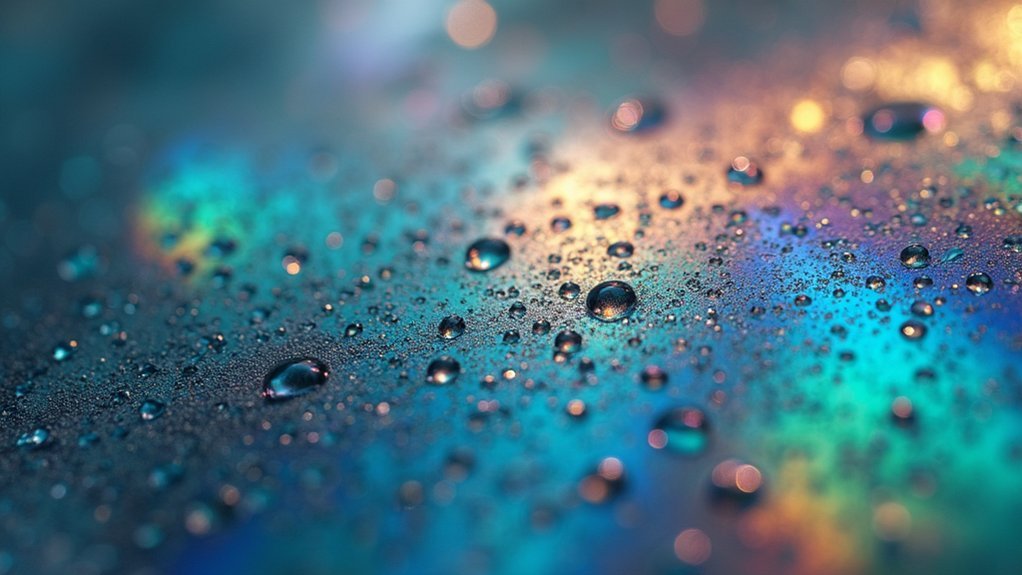
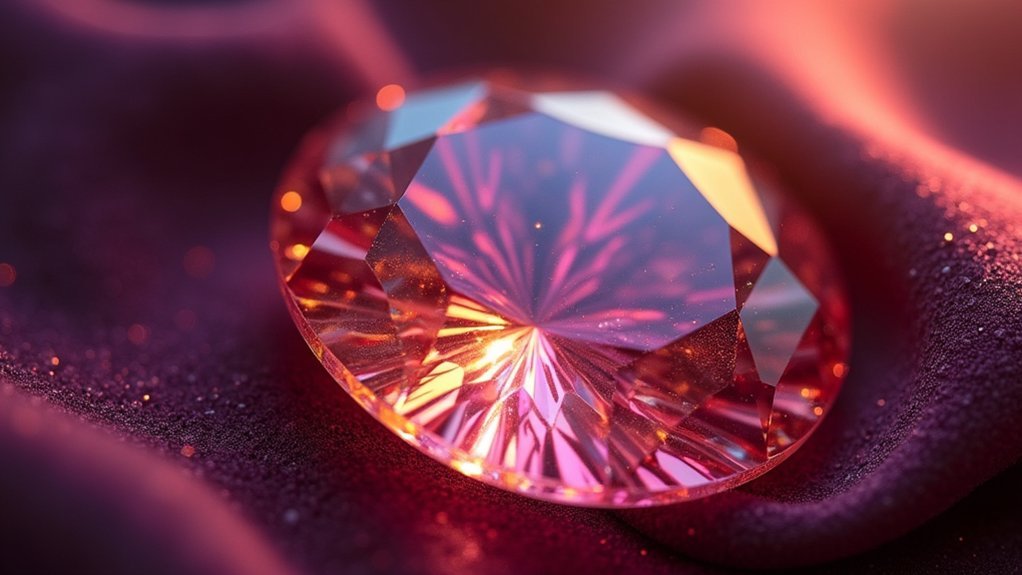
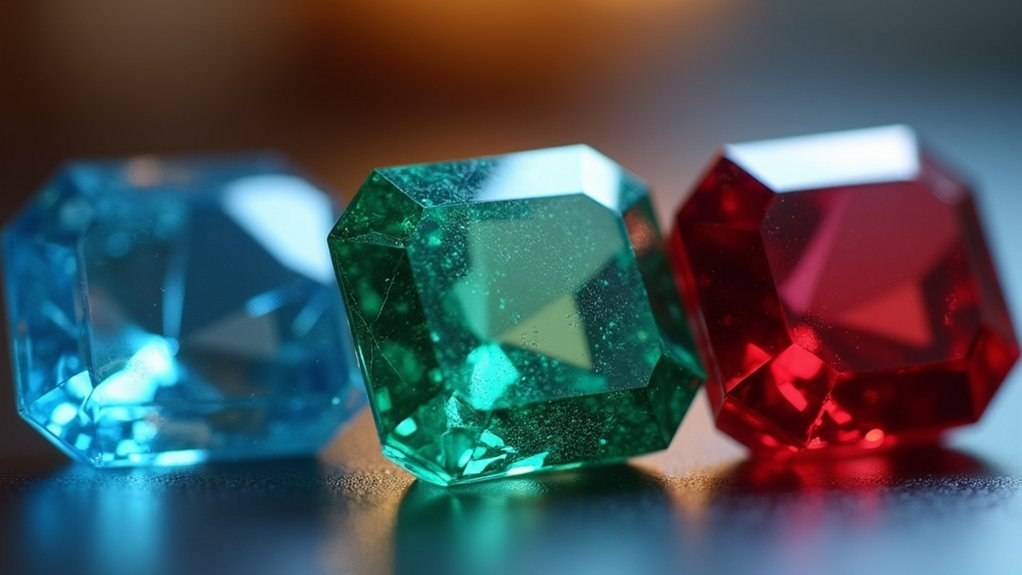
Leave a Reply